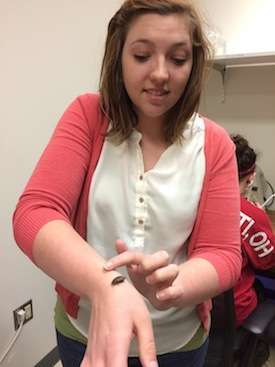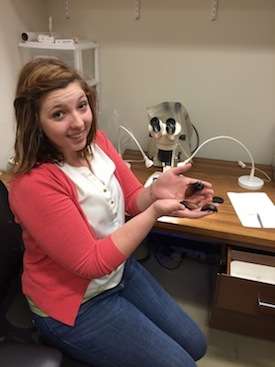Researcher wants to know if cockroaches turn genes off and on to protect their young

The next time you squish a cockroach, consider that you may be killing an opportunity to learn how genes for diseases like Alzheimer's and diabetes get passed down to some generations and not others.
That's generalizing, to be sure, because your garden-variety cockroach isn't part of any scientific study. But the basic premise—that stressors mothers experience while pregnant can trigger the activation or suppression of DNA associated with specific metabolic diseases—serves as the basis for Emily Jennings' award-winning, insect-focused doctoral research in the University of Cincinnati's Department of Biological Sciences.
Jennings was one of four graduate students, three of them female, to snag prestigious Sigma Xi awards to fund specific areas of research this spring. And none of the winners speaks as passionately, and authoritatively, about the power of cockroaches as the 23-year-old Northern Kentucky native.
The fancy name for what Jennings researches is "DNA methylation and transgenerational priming." She focuses on one very special breed of cockroach—the only cockroach that nourishes its embryos with specialized nutrients before birth.
"It's similar to nursing," said Jennings. "It's very specialized, but it's prenatal."
In her lab, Jennings works with what she calls an "army" of undergraduate researchers looking through thousands of samples to figure out what mothers are actually doing to regulate their genes during pregnancy. One example? Diet.
"If the mother's diet is restricted, the progeny's diet may be constricted," she said. "Whether or not it's on purpose, we can't tell that yet."
Preliminary findings do show, though, that mothers' experiences directly impact their offspring—sometimes for good, sometimes not. Jennings and her fellow researchers can use information they learn from cockroaches to see how specific genes are related to development of diseases.
"Cockroaches are actually a pretty good model for what's happening in humans," she said.

Jennings path to the cockroach lab may have started early—she got her first microscope for her sixth birthday—but it was far from straight.
"I have always been fascinated with nature and creepy, crawly little things," she said. "I was in the pink dress digging in the dirt looking for worms."
She graduated from high school when she was just 16 and enrolled as a biology major at Northern Kentucky University. "I always had so many questions."
Those questions led her to switch majors more than once. "I tried majoring in Spanish, tried business, fine arts—I really enjoy painting—tried ecology and psychology," she said.
Once she landed in NKU's psychology department, she realized her studies were coming full circle. She wanted more physical evidence to answer her questions of "why" and "how."
"I needed that biological counterpart," she said. When she discovered that UC offered an undergraduate degree in neuroscience, a rare undergraduate opportunity, she decided to cross the river and change course.
As a neuroscience undergrad, she studied insects and differences in how they see the world, literally. Soon, she found herself more and more intrigued by the genetic systems that determined variations in eyesight between different types of bugs.
Incoming biology faculty member Joshua Benoit's genetic research with cockroaches fascinated her so much that she decided to apply to do her doctoral research with him as her advisor.
"I'm not a super maternal person, but I have this very maternal interest in development," Jennings said.
So she and her research trainees spend every day with their cockroaches, feeding them dog food and measuring each millimeter of their length throughout their lives and pregnancies. But they never name them. "It's kind of sad at the end when you have to process them as samples," Jennings said.
Still, the knowledge gained, and shared, is what matters most to Jennings, which is why the Sigma Xi funding means so much.
"I'm really excited to be able to use the money toward a method that no one in my lab has ever used," Jennings said. She will share that new knowledge with other graduate students as well as undergraduate assistants.
It's the perfect next step in what she hopes will be a career of research and teaching, of "spreading the wealth and spreading the knowledge," she said.
And as for stepping on the cockroach that holds the genetic key to the cure for diseases? Jennings says not to worry. Her research subjects are safely stored behind two tight-sealing doors, so she doesn't even worry about the occasional spill.
"If you see a cockroach on campus," she said, "it's not mine."
Provided by University of Cincinnati

















